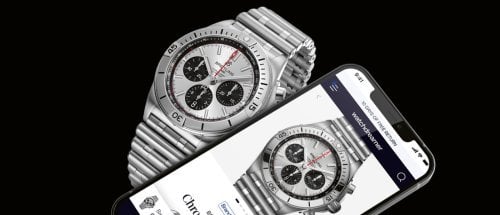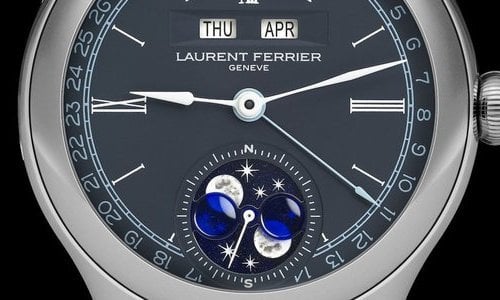
Denis J. Boulle, Owner, de Boulle (Dallas, Texas, USA):
“January started off with a bang. High-end watches keep walking out of the door so we are very optimistic for another good year. I am extremely positive; the economic data seems good to great. Our 80-20 rule of watches, the top three brands of Patek, Rolex and Breguet make up most of our sales. I feel that these brands have a total understanding of the global market place and will continue to do what it takes to increase sales for all their retailers.
”I think we are living in a barbell economy with extreme wealth on one end. We are fortunate enough to be focusing on the high-end of the watch business. The growing group of extremely wealthy individuals will continue to feed the high-end of the market.
“Bigger watches continue to be very strong. A good example of this is the Hublot Big Bang, being as we are unable to keep enough to supply the demand. Also, complicated watches continue to sell well. We see that women are buying bigger, more complicated watches and even, at times, men’s watches.
”The biggest challenge is educating the next generation, X and Y, in regard to the value/collectability/social statement of a high-end mechanical watch. These generations tend to use their cell phones and computers to keep time and hence see no utility for watches."
Jurg Kirchhofer, Owner, Kirchhofer Haute Horlogerie (Interlaken, Switzerland):
“Business is very good especially in the high-end segment. Most suppliers have a problem with deliveries and many items come with huge delays. I think that a very dangerous time is approaching because today's success is the greatest danger for tomorrow's success.
”Some companies have a tendency to overprice some new models, due to the huge demand. It might work short term, but most successful companies give value for money.
“Predictions about the future are always a little more difficult for us due to our very high dependability on tourism. If nothing unusual such as SARS, avian flu or acts of terrorism happen, the outlook is very good.
”The trend is still for large watches and stainless steel with complications. Rose gold is getting stronger in men’s watches, very trendy, with and without complications.
“The industry’s major challenge is to produce enough for consumer demand, without overflowing the markets and to be very careful how and where they sell the rare items. It's very tempting to do short-term business now, for the industry and the retailers.”
Terry Betteridge, Owner, Betteridge Jewelers (Greenwich, Connecticut, USA):
“Business is great: with any luck we'll hit US$100 million this next year. Watches have become a full 30% of our business. I'm pretty sure the big challenge is survival of so many new watch companies. There will be a big falling off of the weak and a consolidation of the strong. At the moment, the creation of new names, movements and distributions is unsustainable. Rolex, Patek and the greats being so tight with merchandise and franchises will leave these new brands out in the cold.”
Sugi Kusumadi, Managing director, Red Army Watches Pte Ltd., Singapore:
“Business has been brisk. People are excited about the fresh new concept [Russian & German watches] and glad there are alternatives available now.
”I have mixed feelings about the state of the industry. It’s good that every brand is spending more money on brand developments, new products and marketing. It’s bad that the industry is getting too cluttered and the fact that many brands are controlled by the same companies. Many brands are losing their artisanal touch. More and more customers are realizing that there is too much hype surrounding the branding efforts and wondering why they should buy an XYZ chronograph when many brands are using the same movement and charging much less. But overall, it’s good for everyone for now. Customers in general still don’t mind paying premium for the 'brand'.
“As a small player, we are very dependent on the big boys to do much of the education, especially on the mechanical watch aspect of it. When they stop seeing a potential in this segment, they will reduce their spending on marketing efforts, and that will be bad for everyone. The threat coming from the digital convergence trend is also eminent especially if we are looking at the future consumers of watches, 'the teens', who are more likely buying a smart phone, IPod, or other electronic gadget (which most likely will have time on it) as opposed to spending the same amount for a watch. This generation will continue doing so when they are into their working age. So let’s hope the big brands continue to do their part to instil interest in this young segment, and convert them into buyers when they are older.
”I am seeing more and more Chinese watches in 'German-made', 'Italian-made' brands. Oversized watches are here to stay. More female buyers are interested in mechanical watches. Due to a low barrier of entry, there are a lot more new brands in the market.
“The biggest challenge for the watch industry is how to sell more watches to a broader pool of customers and how to make existing customers buy more watches. You can see everyone is going after emerging markets (for example, in Russia, China and India) where the potential is not yet fully realized.”
 Karen and Denis Boulle, Jurg Kirchhofer andSugi Kusumadi
Karen and Denis Boulle, Jurg Kirchhofer andSugi Kusumadi
 Bernard Metzger, Marion Halfacre and laurent Picciotto
Bernard Metzger, Marion Halfacre and laurent Picciotto
Bernard Metzger, Managing Director, Horlogerie-Bijouterie Guillard (Lausanne, Switzerland):
“Business is difficult as it has been for some years now but the figures are decent, for example, last year’s plus 8% turnover. We fight to overcome the adversities which are multi-layer.”The industry is doing very well as the released figures prove. The liberalization as well as the constant economic bettering of Asian nations will give them a lot of good time ahead as long as they are able to keep the high quality standards and the creativity.
“The future seems rosy as long as the ’Swiss quality’ watch stays a status symbol and a dream for many of the world’s consumers.”For the time being I feel the brand and not the style will determine the sales potential of a product, although you never know why and for what reason suddenly some funny watch takes the lead. Chronographs are still in demand, though seldom used, and diamonds naturally add flash to the product and that’s where the watch industry is going, puffing up the ego of people with less and less internal values to create the show and the personality they aspire to have.
“The maintaining of quality of the outstanding standards and above all training enough watchmakers to repair the hundreds of thousands of mechanical timepieces which will need servicing in a very short while is the biggest challenge. I really wonder where we are going to find these specialists.”
Marion Halfacre, Owner, Traditional Jewelers (Newport, California, USA):
“In 2006 we hit our goal and had very good business. The current state of the industry is very good which is proven by the consistency of the luxury buyer’s buying power and desire to buy. The luxury buyer isn’t prone to wait for an occasion, but rather grabs the opportunity to acquire a fine luxury piece when it presents itself. We also believe that we have developed keen advertising and marketing strategies that will ensure consistency.”The larger face introduced a few years ago is gaining more and more momentum, with brands developing their designs around this popular look. We have also seen a great increase in inquiries for 18 carat pink gold cases and bracelets. It seems that the buyers are looking at very high-end timepieces more and more.
“The biggest challenges are availability, delivery times, and service.”
Laurent Picciotto, Chronopassion (Paris, France):
“Business is excellent. Creativity is prolific. As competition is rife, players must prove themselves with more ideas. The future of the market, at least for us, is to be on the same wavelength as our clients who expect to be surprised and astonished with different pieces, on a technical and design front and with exclusivity. Mixed sport, the fusion highlighted by Hublot seems to me to be very advanced, today - the Big Bang is the most fun to wear while remaining elegant.”The success of the watch market? Will it last?“Ray Grenon, Owner, Grenon’s of Newport (Newport, Rhode Island, USA):
”Business is excellent particularly at the top end. Entry-level mechanicals are doing well also; the mid-range has slowed a little bit with the ex-ception of the better-known names.
“There are still too many watch companies out there and not enough that are doing something different. The industry is healthy but service must be improved. After-sales service has been lacking for quite some time, which can be attributed to the lack of watchmakers, but when you tour a factory and you see 30 watchmakers making new watches and only two watchmakers doing repairs, you can see the problem.”More of the smaller companies will get swallowed up by the bigger companies. The small companies that are not innovative enough will disappear. Everybody wants to be in the watch business because it is popular right now. People rush out to start their own companies without ever asking, does the watch industry need another company? And more importantly what makes my company different and special? Too many companies are driven by ego so someone can see their name on the dial. There are just too many companies out there and we will see some consolidation.
“Also many companies are rushing to make their own ’in-house movements.’ Just because Swatch is pulling back doesn’t mean that movements will be impossible to find. Also many people brag that their movement is made in-house but can’t answer the question, ’Why is this better than the ETA alternative?’ Just because you made it yourself doesn’t make it better. I made my own tomato sauce once and trust me; the store bought brands are better. Another example of pride getting in the way.”Even the most traditional companies are making larger watches now as they are slowly accepting the fact that the big watch is not just a quick fad.
“After-sales service is the biggest challenge we face. Too many companies are worrying about tomorrow’s sale without taking care of yesterday’s first. Repairs get pushed onto the back burner and take much too long. Especially with the sudden appearance of ’in-house’ calibres. Who will repair these and will parts be readily available?”
Source: Europa Star April-May 2007 Magazine Issue







